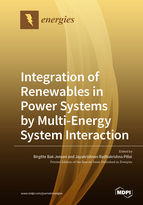Integration of Renewables in Power Systems by Multi-Energy System Interaction
A special issue of Energies (ISSN 1996-1073). This special issue belongs to the section "F: Electrical Engineering".
Deadline for manuscript submissions: closed (30 June 2020) | Viewed by 48179
Special Issue Editors
Interests: multienergy systems; renewables; storages; electrification of transport and heating sector; hierarchical control; demand response; grid flexibility; hosting capacity; power flow; protection in distribution grids
Special Issues, Collections and Topics in MDPI journals
Special Issue Information
Dear Colleagues,
This Special Issue will focus on the interaction between different energy vectors that is between electrical, thermal, gas, and transportation systems, with the purpose of optimizing the future energy system. More and more renewable energy is integrated into the electrical system, and to optimize the usage and ensure that full production can be hosted and utilized, the power system has to be controlled in a more flexible manner—as an example, using excess electricity in the thermal system, using heat pumps or electrical boilers, and storing energy as thermal energy in storage tanks or in the district heating system. Another solution is to use and store electrical energy in the batteries of electrical vehicles, either to be used for transport or to be fed back to the power system again (V2G principle). The gas system can also be involved, using electrolyzers and storing hydrogen. In order not to overload the electrical distribution grid, the new large loads have to be controlled using demand response, perchance through a hierarchal control set-up where some controls are dependent on price signals from the spot and balancing market, but also where local real-time control and coordination are performed based on local voltage or frequency measurements where grid hosting limits are not violated. We welcome contributions on multienergy systems to explore the different possibilities for the future smart energy system with a huge interaction among the different energy systems. The topics of interest include, but are not limited to:
- Modeling, optimization, and analysis of multienergy systems;
- Planning, operation, and control;
- Interaction and coupling between different energy supply systems and networks;
- Flexible demand and energy storages;
- Energy efficiency and management;
- Reliability and security of multienergy systems;
- Cyberphysical systems, information and communication infrastructure, and data analytics;
- Market, social, regulatory frameworks and policies for multienergy systems.
Prof. Dr. Birgitte Bak-Jensen
Assoc. Prof. Dr. Jayakrishnan Radhakrishna Pillai
Guest Editors
Manuscript Submission Information
Manuscripts should be submitted online at www.mdpi.com by registering and logging in to this website. Once you are registered, click here to go to the submission form. Manuscripts can be submitted until the deadline. All submissions that pass pre-check are peer-reviewed. Accepted papers will be published continuously in the journal (as soon as accepted) and will be listed together on the special issue website. Research articles, review articles as well as short communications are invited. For planned papers, a title and short abstract (about 100 words) can be sent to the Editorial Office for announcement on this website.
Submitted manuscripts should not have been published previously, nor be under consideration for publication elsewhere (except conference proceedings papers). All manuscripts are thoroughly refereed through a single-blind peer-review process. A guide for authors and other relevant information for submission of manuscripts is available on the Instructions for Authors page. Energies is an international peer-reviewed open access semimonthly journal published by MDPI.
Please visit the Instructions for Authors page before submitting a manuscript. The Article Processing Charge (APC) for publication in this open access journal is 2600 CHF (Swiss Francs). Submitted papers should be well formatted and use good English. Authors may use MDPI's English editing service prior to publication or during author revisions.
Keywords
- multienergy systems
- renewable energy
- energy storages
- flexible demand
- electrification of transport and heating sector
- hierarchical control
- demand response
- grid flexibility
- hosting capacity






